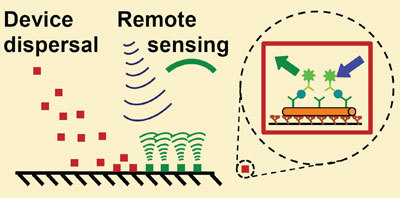
A beehive is a very interesting biosensor: bees disperse from the hive, sample a large area and report their findings back to the hive. The concept of smart dust devices mimics this remote environmental monitoring process. A large number of devices dispersed over an area would be left to interact with a sample and then communicate their findings to scientists from a distance. To be economically feasible, such single-use devices have to be cheap, even cheaper than the radio-frequency identification tags currently used to track the inventory of warehouses, for example. Consequently, the devices cannot be much larger than a grain of sand, thus the name ‘smart dust’. (via Instant insight: Molecular shuttle power)
A beehive is a very interesting biosensor: bees disperse from the hive, sample a large area and report their findings back to the hive. The concept of smart dust devices mimics this remote environmental monitoring process. A large number of devices dispersed over an area would be left to interact with a sample and then communicate their findings to scientists from a distance. To be economically feasible, such single-use devices have to be cheap, even cheaper than the radio-frequency identification tags currently used to track the inventory of warehouses, for example. Consequently, the devices cannot be much larger than a grain of sand, thus the name ‘smart dust’. (via Instant insight: Molecular shuttle power)
The Smarter Planet tumblelog is an outgrowth of IBM’s strategic initiative to help a world of smart systems emerge.
